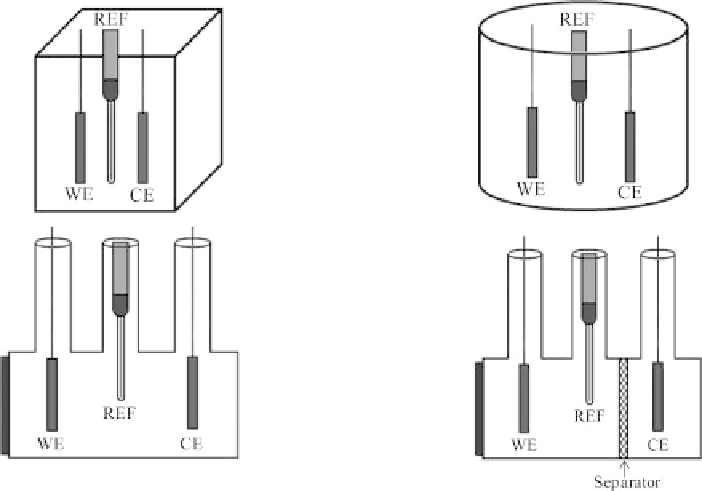Environmental Engineering Reference
In-Depth Information
Figure 10.2.9
Example of PEC cells for water splitting with different designs, in a three-electrode
configuration.
among other more complex cells, such as the ones that allow tandem configurations
(PV
PEC system in a single embodiment) - Figure 10.2.9 (Minggu et al., 2010).
Presently there are some PEC cells available commercially, e.g. Pine Research Instru-
ments Company (Pine Instrument Company); however, these cells are normally limited
in what concerns innovative configurations and characterization methods (Krol and
Grätzel, 2012). The best option is still the PEC cells in-house designed and built.
Figure 10.2.10 shows an example of a versatile PEC cell designed by the authors;
for small (Figure 10.2.10a) and for large photoanodes (Figure 10.2.10b), up to
10
+
10 cm
2
. The developed cells, named
Portocell
, have two removable windows
(front and back) screwed to a transparent acrylic part. The small cell has a mask that
allows an illumination area of 4 cm
2
, crossing a synthetic quartz window (Robson
Scientific, England), which is pressed against an o-ring by means of five screws. After
assembling the black and the transparent acrylic part, the cell is then filled with the
appropriate electrolyte solution where both electrodes are immersed. An acrylic cap
can then be screwed on the top of the cell, allowing a reference electrode to be con-
nected, if a three electrode configuration is desired, or just permitting the evolution
of the electrolysis decomposition gases.
Portocell
permits back and front illumination
and allows one to place a separator between the electrodes to avoid gas (hydrogen
and oxygen) mixture. This separator can be a Nafion® membrane that allows just
protons to permeate or a porous hydrophobic Teflon® membrane, which exhibits a
very small ionic transfer resistance and prevents hydrogen and oxygen gas bubbles to
mix (Mendes, et al., under protection).
×

Search WWH ::

Custom Search